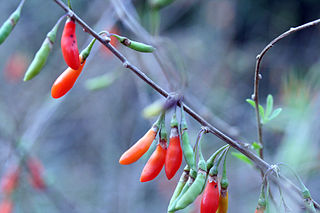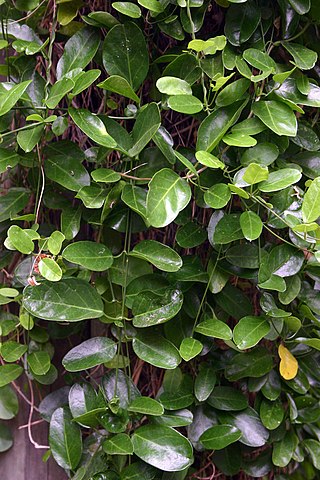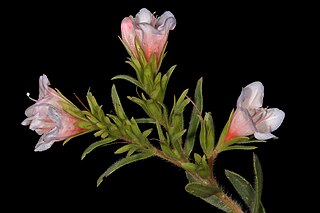
Lycium is a genus of flowering plants in the nightshade family, Solanaceae. The genus has a disjunct distribution around the globe, with species occurring on most continents in temperate and subtropical regions. South America has the most species, followed by North America and southern Africa. There are several scattered across Europe and Asia, and one is native to Australia. Common English names for plants of this genus include box-thorn, wolfberry, and desert-thorn. There are about 70 to 80 species.

Lycium chinense is one of two species of boxthorn shrub in the family Solanaceae. Along with Lycium barbarum, it produces the goji berry ("wolfberry"). Two varieties are recognized, L. chinense var. chinense and L. chinense var. potaninii. It is also known as Chinese boxthorn, Chinese matrimony-vine, Chinese teaplant, Chinese wolfberry, wolfberry, and Chinese desert-thorn.

Cotyledon is one of some 35 genera of succulent plants in the family Crassulaceae. Mostly from Southern Africa, they also occur throughout the drier parts of Africa as far north as the Arabian Peninsula. Ten of its species are mostly confined to South Africa, where unlike Tylecodon, they occur commonly in both the winter and summer rainfall regions. They may be found on coastal flats and rocky hillsides, or as cremnophytes on cliff faces. Their decussate, evergreen leaves are very variable in shape, even within some species, but the flowers are, apart from colour, very similar.

Lycium ferocissimum, the African boxthorn or boxthorn, is a shrub in the nightshade family (Solanaceae) indigenous to South Africa.

Cestrum fasciculatum is a species of flowering plant in the family Solanaceae known by the common names early jessamine and red cestrum. It is native to central Mexico, but it is also kept elsewhere as an ornamental plant. This is a gangly evergreen shrub reaching a maximum height of over two meters. The stems, and especially new twigs, are sometimes purple in color and slightly hairy. It bears hairy, oval-shaped, pointed green leaves up to 13 centimeters long. Plentiful inflorescences appear at the tips of stem branches, each a dense cluster of up to 10 hairy red flowers. Each tubular flower is 2 or 3 centimeters long, counting the elongated calyx of sepals and the long corolla. The fruit is a berry about 1.5 centimeters wide which is red on the outside and white inside with about 10 small brown seeds.

Iochroma arborescens is a species of flowering plant in the genus Iochroma, belonging to the nightshade family Solanaceae. Formerly it was considered the single species in the monotypic genus Acnistus. Common names include gallinero, mata-gallina, fruta-de-sabiá, hollowheart, wild tobacco, siyou, bastard sirio, galán arbóreo, tabaco de monte, nigüito, marieneira, güitite, and tabak djab.

Lycium fremontii is a species of flowering plant in the nightshade family, Solanaceae, that is native to northwestern Mexico and the southernmost mountains and deserts of California and Arizona in the United States. It often grows in areas with alkaline soils, such as alkali flats.
Trompettia cardenasiana is a species of nightshade that is a spiny shrub bearing very small leaves, 0.35–0.5 cm (0.1–0.2 in) by 0.1–0.12 cm (0.04–0.05 in), a yellow trumpet-shaped campanulate flower, measuring about 3 cm (1.2 in) long and globose fruit. The growth habit is somewhat reminiscent of certain Lycium species. It is endemic to Bolivia, growing in dry, Andean valleys at altitudes of 2,000–2,500 m (6,600–8,200 ft) and 3,000–3,500 m (9,800–11,500 ft) and has been collected near the town of Cotagaita in Potosí Department.

Cynanchum ellipticum is a South African climbing plant of the family Apocynaceae, with slender stems and branches, exuding milky, bitter latex that is non-irritant. It occurs in coastal scrub from Cape Town as far north as Mozambique and further inland up to 1300 m, and may be found on flats or moderate slopes, in sand or between rocks, in indigenous forests and along forest margins and thickets, frequently occurring in disturbed habitats.

Lycium afrum, the kraal honey thorn is a shrub in the potato family (Solanaceae), indigenous to the Western Cape Province, South Africa.

Petalidium, commonly known as petal-bushes, is a genus of perennial shrubs in the acanthus family. They are native to sandy flats or stony slopes in the drier bush regions of Africa, India and the Mascarene Islands. The majority of species occur in frost-free, summer rainfall regions of southern Africa, and may be found from low to medium altitudes.

The Solanaceae, or the nightshades, are a family of flowering plants that ranges from annual and perennial herbs to vines, lianas, epiphytes, shrubs, and trees, and includes a number of agricultural crops, medicinal plants, spices, weeds, and ornamentals. Many members of the family contain potent alkaloids, and some are highly toxic, but many—including tomatoes, potatoes, eggplant, bell and chili peppers—are used as food. The family belongs to the order Solanales, in the asterid group and class Magnoliopsida (dicotyledons). The Solanaceae consists of about 98 genera and some 2,700 species, with a great diversity of habitats, morphology and ecology.

Cycnium tubulosum, also known as the vlei ink-flower and the tissue paper flower, is a slender hemiparasitic perennial plant of the broomrape family. Its range includes much of southern and eastern Africa, from South Africa to Ethiopia, including Madagascar. It has creeping, straggling or upright stems, with few narrow, entire leaves and erect, white or pinkish, slightly zygomorph flowers on a long tube, with five lobes, reminiscent of a Phlox-flower. It may not always be fully dependent on the supply of minerals by other plants, but usually makes connections with the roots of grasses. It can be found in moist, short grasslands, reaching altitudes of about 1,550 m (5,090 ft). Its conservation status in South-Africa is "least concern".

Atropanthe is a monotypic genus of flowering plants belonging to tribe Hyoscyameae of subfamily Solanoideae of the family Solanaceae.

Lobostemon fruticosus, also known as the eightday healthbush or pyjamabush, is a species of medicinal plant endemic to the Cape Provinces of South Africa. It is considered to be ecologically and economically important but is declining due to overexploitation.

Nemesia linearis, also known as the witleeubekkie in Afrikaans, is a species of plant from southern Africa. It is found in South Africa and Namibia.

Lycium oxycarpum is a shrub in the nightshade family (Solanaceae) indigenous to the Karoo regions of South Africa.
Lycium pumilum is a shrub in the nightshade family (Solanaceae) indigenous to South Africa and Namibia.
Lycium cinereum is a shrub in the nightshade family (Solanaceae) indigenous to southern Africa. It is widespread across South Africa, as well as southern Namibia and Botswana.
Lycium tenue is a shrub in the nightshade family (Solanaceae) indigenous to South Africa.
















